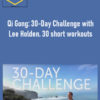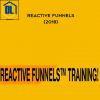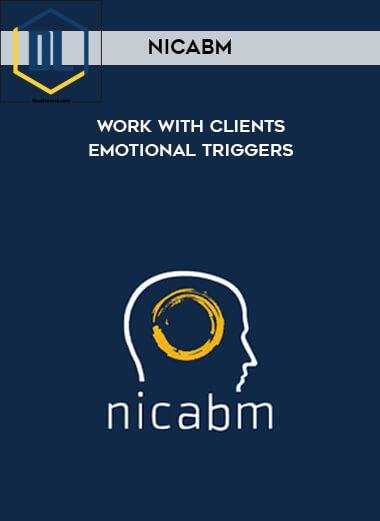NICABM – Work with Client’s Emotional Triggers
$34.00 Original price was: $34.00.$17.00Current price is: $17.00.
Description
NICABM – Work with Client’s Emotional Triggers
Salepage: NICABM – Work with Clients Emotional Triggers
How to Help Your Client Manage Their Emotional Triggers with Practical Skills They Can Use in Real Time
When clients get triggered, it can set off a chain reaction of emotional overwhelm and reactivity.
So how do we help clients shift out of this difficult cycle when their nervous system starts to rev up (or shut down)?
First, we need specific strategies that can keep clients from becoming overwhelmed when difficult emotions get triggered.
Then we have to help clients learn how to interrupt powerful behavior-trigger-reward loops.
From there, we have to address the emotional triggers associated with trauma and attachment wounds.
Most importantly, we have to help clients carry this work out into the real world so that they can function more fully and effectively.
That’s why we got together with 26 top experts and asked for their best strategies for working with clients’ emotional triggers. For the first time ever, all their expert insights have been gathered in one place . . .
How to Work with a Client’s Emotional Triggers
The Neurobiology of an Emotional Trigger
Ron Siegel, PsyD Dan Siegel, MD

- How the brain primes us for emotional triggers
- Two ways the brain processes emotion that can fuel emotional sensitivity
- The trigger pipeline that connects unprocessed feelings to impulsivity
How to Help Clients Avoid Being Overwhelmed When Strong Emotions Are Triggered
Shelly Harrell, PhD Lynn Lyons, LICSW
Kelly McGonigal, PhD Joan Borysenko, PhD
Rick Hanson, PhD

- The “Band-Aid” strategy to prevent an emotional wound from getting triggered
- The trigger-resistant mindset that can help clients escape a reactivity cycle
- How to keep your client regulated when an emotional trigger gets tripped
How to Prevent Vulnerabilities from Turning into Painful Triggers
Michael Yapko, PHD Deany Laliotis, LICSW
Joan Borysenko, PhD Ron Siegel, PsyD

- One question that can hit the “pause button” on a client’s trigger response
- A simple reframe that can disarm the power of an emotional trigger
- How to connect clients with trigger-resistant resources to keep them from being emotionally flooded
How to Break Habit-Trigger-Reward Loops
Donald Meichenbaum, PhD Kelly McGonigal, PhD
Judson Brewer, MD, PhD

- One simple strategy that can shift a blamer out of their deeply-ingrained justifications
- How to help clients reduce the shame they attach to their reactivity
- Why shame can glue clients to their triggers
- Why guilt makes an emotional trigger so much more powerful (and how to undo this)
- How to help clients visualize their trigger sequence to find their pain points
How to Work with a Client Whose Nervous System is Easily Triggered
Stephen Porges, PhD Deb Dana, LCSW
Kelly McGonigal, PhD

- How a trigger response can block a client’s ability to process safety cues
- How a triggered physiology can spark a downward spiral of negative experience
How to Help Clients Who Dissociate When Triggered
Christine Padesky, PhD Pat Ogden PhD
Rick Hanson, PhD

- The vital first step before working with a dissociated client
- How to strengthen a client’s emotional tolerance when they dissociate
- A simple strategy to neutralize emotional overwhelm and prevent dissociation
How To Work with Emotional Triggers Connected to Trauma
Resmaa Menakem, MSW, LICSW Peter Levine, PhD
Kelly McGonigal, PhD Ron Siegel, PsyD
Rick Hanson, PhD

- How traumatic memory can lead to unpredictable triggers
- How to safely foster better present-moment awareness in traumatized clients who feel disconnected from their body
- How to avoid getting triggered by a client’s high-octane reactivity
How to Help Clients Build Powerful Self-Regulation Skills
Ron Siegel, PsyD Terry Real, MSW, LICSW
David Wallin, PhD Kelly McGonigal, PhD
Rick Hanson, PhD

- One critical skill that can prevent triggered emotions from escalating
- How to work with clients who have become attached to their reactive response
- A 3-step approach to help clients take back control from their trigger
How to Work with Triggers Fueled by Negative Attachment
Richard Schwartz, PhD Pat Ogden, PhD
Rick Hanson, PhD

- Why it’s crucial to discriminate whether a trigger’s origin is trauma or attachment
- How to work with the 3 main fears that can undermine the treatment of triggers
How to Neutralize a Reactivity Pattern
Kelly Wilson, PhD Zindel Segal, PhD

- The first two steps in addressing a trigger response that can profoundly affect outcome
- How to help diminish a client’s road rage that’s leaving them tired and angry
- How to expand a client’s capacity to choose a better response to their trigger
- One way to help a war veteran shift a core belief that’s fueling their trigger
How to Help Clients Shift from Reactivity to Healing
Bill O’Hanlon, LMFT Kelly McGonigal, PhD
Steven Hayes, PhD

- A strong coping strategy for the unmet needs that drive reactivity
- How to deepen a client’s context sensitivity to increase the space between trigger and reaction
Readmore about: NICABM
Delivery Policy
When will I receive my course?
You will receive a link to download your course immediately or within 1 to 21 days. It depends on the product you buy, so please read the short description of the product carefully before making a purchase.
How is my course delivered?
We share courses through Google Drive, so once your order is complete, you'll receive an invitation to view the course in your email.
To avoid any delay in delivery, please provide a Google mail and enter your email address correctly in the Checkout Page.
In case you submit a wrong email address, please contact us to resend the course to the correct email.
How do I check status of my order?
Please log in to TheDLCourse account then go to Order Page. You will find all your orders includes number, date, status and total price.
If the status is Processing: Your course is being uploaded. Please be patient and wait for us to complete your order. If your order has multiple courses and one of them has not been updated with the download link, the status of the order is also Processing.
If the status is Completed: Your course is ready for immediate download. Click "VIEW" to view details and download the course.
Where can I find my course?
Once your order is complete, a link to download the course will automatically be sent to your email.
You can also get the download link by logging into your TheDLCourse account then going to Downloads Page.









